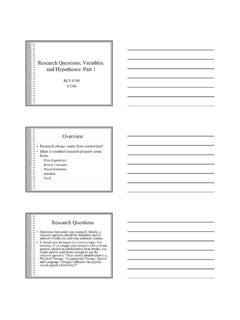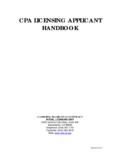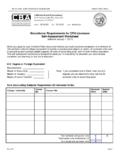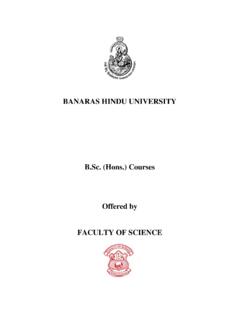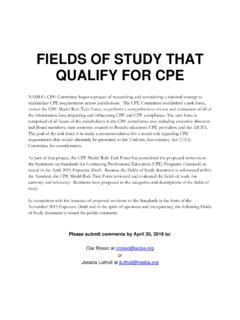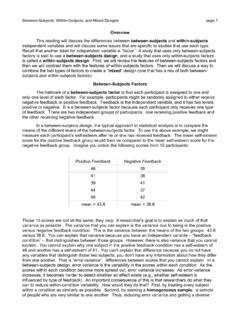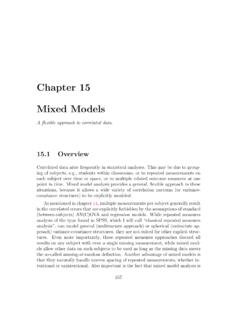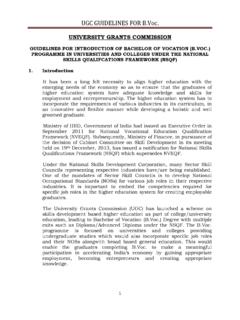Transcription of VALIDITY OF QUANTITATIVE RESEARCH
1 VALIDITY 1 VALIDITY OF QUANTITATIVE RESEARCH Recall the basic aim of science is to explain natural phenomena. Such explanations are called theories (Kerlinger, 1986, p. 8). Theories have varying degrees of truth. VALIDITY is the best approximation to the truth or falsity of propositions (Cook & Campbell, 1979). VALIDITY is at best approximate or tentative since one can never know what is true. At best, one can know what has not yet been ruled out as false (Cook & Campbell, 1979, p. 37). And, as we have seen in examining the logic of hypothesis testing, statistical power, and the VALIDITY of outcome measures, we don t really prove that something is false. In other words, we never really prove a null hypothesis; we only fail to reject it.
2 Experimental results never confirm or prove a theory -- rather the successful theory is tested and escapes being disconfirmed (Campbell & Stanley, 1963, p. 35). In other words, we fail to reject the null hypothesis. Varying degrees of confirmation are conferred upon a theory through the number of plausible rival hypotheses available to account for the data. The fewer such plausible rival hypotheses remaining, the greater the degree of confirmation (Campbell & Stanley, 1963, p. 36). Thus, RESEARCH is a field of varying degrees of certainty. [Analogy: Monet s garden.] And, continuous, multiple experimentation is more typical of science than once-and-for-all definitive experiments (Campbell & Stanley, 1963, p.)
3 3). [Analogy: Brush strokes in the painting.] Threats to VALIDITY are plausible rival hypotheses ( , other ways of explaining the results rather than the author(s) hypothesis). RESEARCH design helps us to eliminate some threats to VALIDITY in individual studies. And, multiple studies with different participants, investigators, and conditions increase the degree of confirmation that can be accorded to a particular theory. VALIDITY 2 TYPES OF VALIDITY (Or, the multitude of sins that can be committed in doing RESEARCH ) Campbell and Stanley (1963), Cozby (2001), and others classify VALIDITY as internal VALIDITY and external VALIDITY . Cook and Campbell (1979) added two additional types: statistical conclusion VALIDITY (often considered under internal VALIDITY ) and construct VALIDITY of causes or effects (often considered under internal VALIDITY ).
4 There is much debate about (a) which types of VALIDITY apply to which types of RESEARCH , (b) the relative priority of types of VALIDITY , and (c) the interrelation of the types (Pedhazur & Schmelkin, 1991). To some degree, the types of VALIDITY that one considers applicable depend on the definitions used for each type of VALIDITY and the type of RESEARCH attempted. All of the group QUANTITATIVE designs depend on the establishment of a relationship among the variables. In some designs ( , experimental) it is a causal relationship; in other designs ( , ex post facto) it is not. And to some degree, all of the types of VALIDITY that we will discuss involve establishing the certainty of the relationship among the variables.
5 Thus, in the broad sense, all of the types of VALIDITY may be considered applicable to all group QUANTITATIVE designs. To a more limited degree, the four types of VALIDITY can be considered to be applicable to single subject designs. Following are definitions of types of VALIDITY and lists of potential threats to each. The material is summarized from Chapter 2 of Cook and Campbell (1979) and Parker (1990). Internal VALIDITY : VALIDITY with which statements can be made about whether there is a relationship between the variables in the form in which the variables were manipulated or measured. Statistical Conclusion VALIDITY : Certainty of inferences about presumed covariation of variables at specified alpha level and variances or, in other words, relative probability that the results of the statistical tests are representative of actual relationships in the data.
6 Construct VALIDITY : Approximate VALIDITY with which we can make generalizations about higher-order constructs from RESEARCH operations. External VALIDITY : Certainty of generalizability across populations, persons, settings, times, etc. VALIDITY 3 Internal VALIDITY : VALIDITY with which statements can be made about whether there is a relationship between the variables in the form in which the variables were manipulated or measured (Cook & Campbell, 1979). Internal VALIDITY may or may not relate to whether or not a causal relationship can be established. Internal VALIDITY refers to our relative certainty that our outcomes resulted from what we did or what we tested (Tuckman, 1988). Some Threats to Internal VALIDITY History For example, an event other than the treatment that occurs between the pre- and post-test).
7 Maturation Changes in the subject that occur naturally with time; the changes affect the subjects performance on the dependent variable differentially. Testing Refers to the fact that pre-testing may sensitize subjects in ways that affect the posttest scores more for the pre-tested subjects than others. Instrumentation Refers to the deterioration or changes in the accuracy of devices or observers used to measure the dependent variable, , observers forget their training. Statistical Regression Grouping on the basis of scores tends to be inaccurate; extreme scorers measures tend to regress toward the group mean. One or two items answered differently more drastically affects extreme scorers than those scoring near the mean.
8 Mortality The loss of subjects during RESEARCH due to death, absence, etc. This is a particular problem if the treatment causes mortality; the treatment groups posttest mean would be contaminated by mortality. Selection This occurs when subjects are assigned to treatment and control groups on a nonrandom basis. This results in the groups being different on many variables. Interaction of Any two of the above threats to internal VALIDITY may interact Selection, to restrict the VALIDITY of the design. Maturation, etc. VALIDITY 4 Some Ways to Minimize Threats to Internal VALIDITY (or to Control Error Variance) Random assignment of subjects to treatment or control groups Holding extraneous variables constant or restricting their range Including extraneous variables in the design to measure their effects Employing methods of statistical control Matching subjects in the treatment and control groups on contaminating, extraneous variables (Parker, 1990) Note that these methods of control are listed in their order of preference.
9 Statistical Conclusion VALIDITY : Certainty of inferences about presumed covariation of variables at specified alpha level and variances (Cook & Campbell, 1979) or, in other words, relative probability that the results of the statistical tests are representative of actual relationships in the data. Some Threats to Statistical Conclusion VALIDITY Low statistical power (topic of earlier lecture) Violated assumptions of statistical tests Fishing and the error rate problem (five neon tetras in the fish tank) Mistaken acceptance of null hypothesis Reliability of measures Reliability of treatment implementation (how much subjects learned, degree of program implementation) Some Ways to Reduce Threats to Statistical Conclusion VALIDITY Do a pre-analysis statistical power estimation and consider obtaining more participants, raising alpha, or using a more powerful statistical test to achieve higher power.
10 Power of .80 is desirable (Cohen, 1988). Use alpha reduction procedures when running multiple comparisons. Be sure that the instruments that you use are reliable. Avoid using gain scores, or use them with appropriate caution. We will discuss the problems of gain scores in a future session. Ferguson and Takane (1989, pp. 474-475) and Cook and Campbell (1979, pp. 182-185) address the problems of gain scores. VALIDITY 5 Be sure that treatments are fully implemented. Understand the assumptions that accompany the statistical tests that you are using and the consequences of their violation under various circumstances. Remember, we don t prove the null hypothesis; we only fail to reject it.
